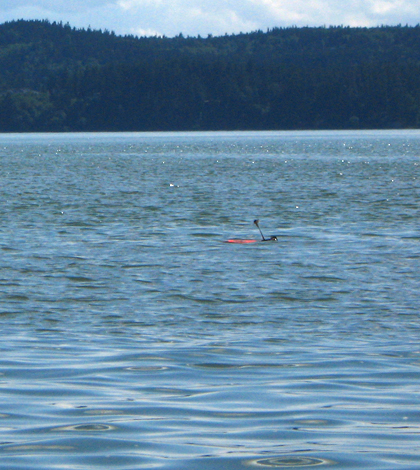Scientists’ custom drifters float sensors over Skagit Bay’s shallow tidal flats

A custom drifter at work on Skagit Bay (Credit: Julia Mullarney and Stephen Henderson)
Scientists studying the flow dynamics and turbulence in the tidal flats of Skagit Bay, Wash., found that the standard gear floating instruments along surface currents weren’t going to cut it in the extremely shallow environments where they were working.
But after raiding the plumbing stores around Portland and picking up a few pounds of feed corn, the researchers had themselves a fleet of sub-hundred-dollar drifters that could carry their $10,000 instruments across the shallow flats while keeping the sensors high enough in the water column to collect high-quality data.
“It’s sort of a contrast when you see the pictures of the drifters we put together,” said Julia Mullarney, lecturer in the Department of Earth and Ocean Sciences at the University of Waikato in New Zealand. “It’s high-tech and low-tech beautifully combined.”
While studying the Skagit around 2008, Mullarney and research partner Stephen Henderson of Washington State University noticed conspicuous fronts forming along the boundary of the ocean water flowing in with the incoming tide and the freshwater flowing out from the Skagit River.
They hoped to get a handle on what was going on in with the flow dynamics the fronts. Drifting instruments is a go-to method for tracking surface currents, but many standard drifter setups draw a half to a full meter of water, making them useless in the 20-centimeter depths of the Skagit tidal flats.
What’s more, the researchers also wanted a driver that could carry an acoustic Doppler current profiler that would provide data on not just the surface currents but also the flow structure throughout the water column. ADCP data would also give an indication of turbulence.
Without a suitable drifter option on the market, Henderson and Mullarney designed and assembled their own model from 6-centimeter-diameter PVC pipe. They fine-tuned their drifter’s buoyancy with what they elegantly refer to as “granular ballast” in a recent paper published in the journal Limnology and Oceanography: Methods.

Each member of the drifter fleet was named after a Teenage Mutant Ninja Turtle, which Mullarney says she blames on a student. (Credit: Julia Mullarney and Stephen Henderson)
“We had to fill them up with something so they would float just under the water surface,” Mullarney said. “The thing we actually ballasted them with was feed corn.”
It did the trick. During deployments in Skagit Bay in 2008 and 2009, a fleet of five drifters rode low enough in the water that the researchers are reasonably sure that their courses were the result of flows and not wind. The ADCP captured data from the bed up to 18 centimeters below the water surface. They estimate other drifter models would have limited that to some 60 centimeters below the surface.
While standard drifters only give an indication of surface water flows, their ADCP-equipped version gave them the data necessary to resolve sheared flows within the water column, wave heights and turbulence. They found that almost every time a drifter crossed a tiny subtidal channel, they’d see sudden enhancement of the turbulence.
“That’s not wholly surprising, but it’s probably the first time it’s been measured, and certainly in this kind of depth,” Mullarney said.
All in all, Mullarney said the drifters performed very well in the shallow environment, and the ADCP collected high-quality measurements. She continues to work with drifters in New Zealand, having moved up to a model that traded in PVC-cemented joints for welded ones. She’s interested in building more low-cost models, though the design might see some simplifying revisions.
“If I’d have been sensible, we would have made them with some sort of weighted life ring rather than glueing them together ourselves,” she said. “But that brilliant idea did not come to me until recently.”
Top image: A custom drifter afloat on Skagit Bay (Credit: Julia Mullarney and Stephen Henderson)




0 comments